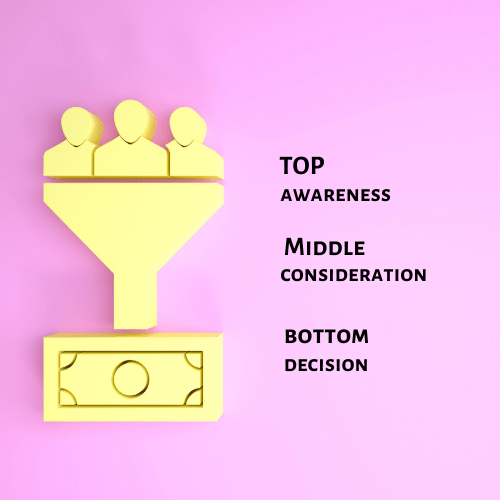Blogs are a great way to educate and inform your clients of what they need to know before they’re ready to engage with you. With this in mind, having blogs that cover off each section of your sales funnel is one way you can connect with clients at all stages of their journey with you. Driving them through the funnel!
What’s a sales funnel?
Well, a sales funnel is a fancy marketing term used to describe how you take a client through to completing an action with you. The action at each stage of the sales funnel is to move people on to the next part of the journey. And the final point is to engage with you. To book now, buy now, or download a freebie.
How blogs can help your sales funnel
Generally there are 3 stages to a sales funnel: Awareness, consideration and decision. You can use blogs that are relevant to each stage of your sales funnel to attract customers at different stages of their journey and move people through to the next stage of your sales funnel.
Top of the funnel blogs (Awareness stage)
Where’s your client at?
- What’s the problem
- Is there a problem
At the top of your sales funnel your clients are becoming aware that there’s a problem. They don’t know the specifics of the problem or how to fix it. They’re only AWARE there is a problem.
Blog topic examples that are relevant to top of the funnel clients are:
- Why does my shoulder hurt?
- Why am I feeling bloated?
- What is diabetes?
You’ll notice that topics in top of sales funnel blogs are the ‘why’ and ‘what’ questions rather than ‘how’ and ‘where’. They’re also very general to what may be going on. Think ‘foot pain’ rather than ‘plantar fasciitis’. Remember your client is only just becoming aware there is a problem.
Choosing your top of funnel blog topics
- Think of WHY your clients first make contact with you
- What questions do they have in that first discovery call?
- What questions might they ask Google or Siri when they’re first aware that they have the problem you can help them solve?
Middle of the funnel (Consideration stage)
Where’s your client at?
- I know there’s a problem
- I know there are different ways to fix my problem
- I want to compare how to fix my problem
At the middle of your sales funnel your clients are aware there’s a problem and are now thinking about what to do about it. They’re looking at different ways to fix their problem. Making comparisons and checking out different treatments or interventions.
Blog topic examples that are relevant to middle of the funnel clients are:
- Strapping or acupuncture for rotator cuff injury
- How to stop bloating by summer
- Low carb diets for managing diabetes
Middle of sales funnel blogs are the ‘how’ and ‘when’ questions. You’ll see they’re becoming more specific. Your client has done some research and found out what the problem is and now they’re looking at different treatment options.
Choosing your middle of funnel blog topics
- Think of HOW questions your clients may ask: how to stop, how to start, how to manage …
- Comparison blogs: this vs that
- When a certain treatment or product is needed
- How to get started blogs
Bottom of the funnel (Decision stage)
Where’s your client at?
- I know I want this particular way to fix my problem
- Do I do it myself
- Can you do it for me
At the bottom of your sales funnel your clients know the problem. They know the solutions and are making the decision of what solution to choose.
Blog topic examples that are relevant to bottom of the funnel clients are:
- Why a physio is best to treat your rotator cuff injury
- Low FODMAP checklist
- FAQ about managing your diabetes
Bottom of sales funnel blogs are the details questions. They’re product or treatment specific. And they might be questioning whether they can DIY-it or what a professional may add to the experience.
Choosing your top of funnel blog topics
- FAQ blogs
- Checklist blogs
- Product/brand/treatment review blogs
How to write blogs that drive clients through your sales funnel: the next steps
So, that’s how your blogs can be used to drive clients through your sales funnel.
The next step is to find out what blogs you have under each sales funnel stage. This will help you identify what’s missing from your blogs. Aim to have at least 3-4 blogs for each stage of the sales funnel.
Super-size your value
Link to a blog in the next stage of the sales funnel so your client can learn more. Top links to middle, middle links to bottom. Don’t hop from top to bottom!
Make your call to action relevant to that stage of the sales funnel (don’t point to a buy now from a top of sales funnel blog. Point to a free download to discover more).
Let's talk about your blog strategy.

